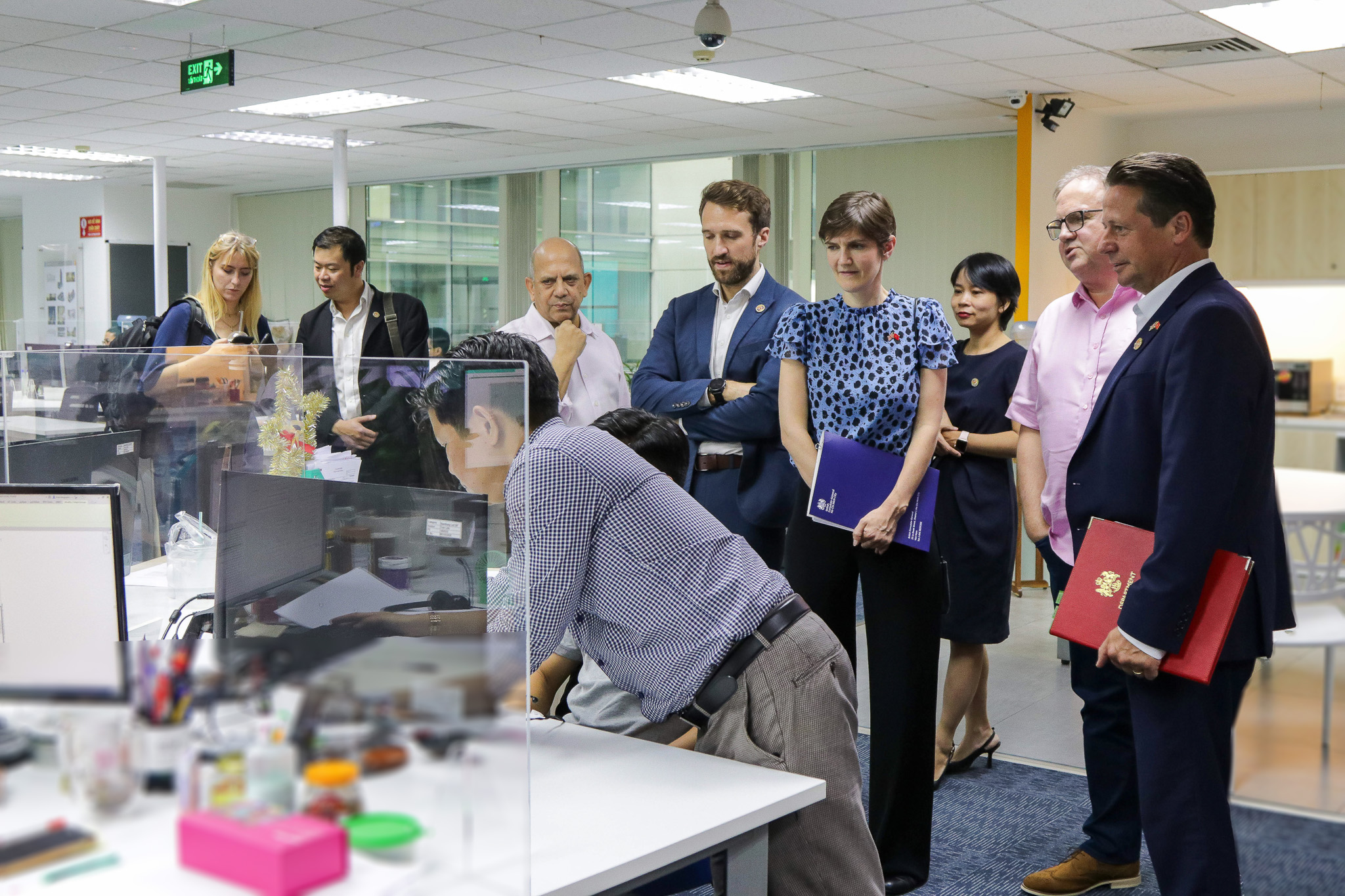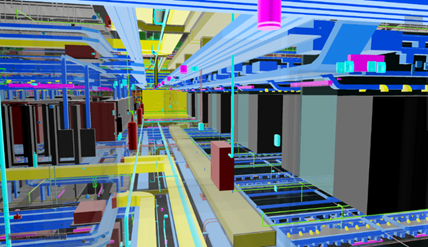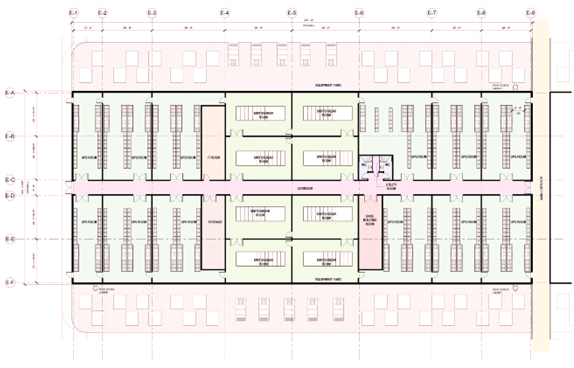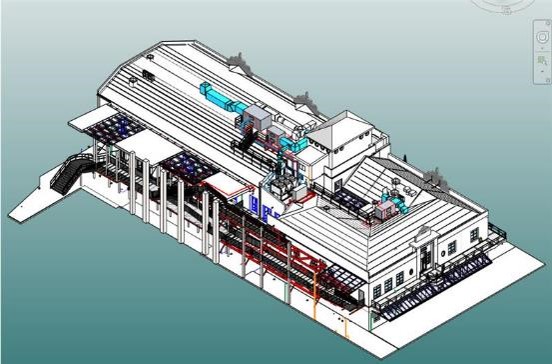Atlas Welcomes Visit From British Government Representatives To
Ho Chi Minh Office

Recently, Atlas had the honor of welcoming Mr. Nigel Huddleston MP - the UK Government Minister for Trade and Ms. Emily Hamblin - Consul General in Ho Chi Minh City for a visit to Atlas’ head office.

Members of the Atlas team led the Minister and Consul General on an office tour, offering a first hand glimpse into Atlas’ services, expertise, and vibrant company culture during the visit. It was an occasion to showcase the breadth of innovative architectural, engineering and infrastructure projects that Atlas is engaged on globally, the cutting-edge technologies applied, and the talented professionals who drive our success.

This visit allowed Atlas to demonstrate to the Minister how we are assisting UK based clients in responding to the requirements of the recent Building Safety Act, discuss the impact of AI on the industry, our training collaboration programmes with local Universities, reinforcing our commitment to supporting our partners in shaping the future of the AEC industry globally.
Related news :
Recognised today as the “fifth utility” alongside water, electricity, gas, and telecommunications, data centres have become essential to modern infrastructure. The global data centre construction pipeline is forecast to peak at USD$92.5billion in 2026 (source: GlobalData). While this represents a slight slowdown from 2025, long-term investment is expected to grow significantly, driven by the surge in cloud computing, artificial intelligence, and digital services that will continue to increase global data traffic over the next decade (source: GlobalData).
Data centres are among the most technically complex and time-critical projects in the built environment. They demand precise coordination, robust engineering solutions, and rapid delivery to meet operational and commercial imperatives.
Governments and industry stakeholders are increasingly focused on balancing these demands with sustainability and land-use priorities. For example, Singapore’s Green Data Centre Roadmap encourages developers to address environmental impacts and resource availability—particularly water and energy—when selecting sites. In other regions, competing pressures on land use is forcing decision-makers to weigh the need for digital infrastructure against essential uses such as housing.
Whether delivering a new greenfield facility, as-built documentation, or repurposing an existing asset, success hinges on the seamless integration of architectural and engineering expertise. This is where specialised multidisciplinary collaboration with a partner such as Atlas helps clients navigate complexity, accelerate programmes, and ensure quality outcomes.
Case in point: Collaboration to Fast-Track MEP Detailed Design
The delivery of a new greenfield facility in Malaysia was underway, and our client was seeking, at short notice, a delivery partner to fast-track the MEP detailed design stage during their annual holiday season. Due to an increase in the data centre’s capacity, modifications were required to the MEP external services such as HV, LV, telecom, HVAC, fire protection and water supply.
Atlas rapidly mobilised a specialist MEP team to provide a fully integrated BIM delivery solution with clash coordination and resolution support. From the client supplied 60% detailed design stage MEP BIM model, it was up to our MEP engineers and technicians to deliver from this a 90% LOD 300 model and 2D documentation.
By leveraging our MEP BIM expertise, the client successfully met their programme—even during their annual holiday period—while maintaining quality and coordination.

Case in point: Collaboration to Accelerate End-User Negotiations
Our client in North America was transforming an existing two-storey commercial building into a state-of-the-art data centre. This required significant building works, including extending the existing structure, partially raising the roof, and undertaking a full interior refurbishment to accommodate the technical and operational demands of the proposed new facility.
To support negotiations with end-users, test-fit proposals were required to demonstrate how the space could be configured and function in practice.
Working to a tight timeframe, our multidisciplinary team created a detailed BIM model and developed, and test fitted multiple design options in parallel to providing full MEP services design.
High-quality presentation drawings enabled the client to present a range of well-considered proposals to their end-user within the demanding timeframe.

Case in point: Collaboration to Digitise Existing Data Centres
To support the digitisation of two existing data centre buildings, our client required the creation of accurate as-built BIM models within a tight timeframe. With no existing BIM models available, the 3D models had to be built from scratch.
From hundreds of supplied PDF and as-built CAD (dwg) drawings, Atlas developed 3D models from the ground up. With a dedicated team of six engineers and technicians we delivered the first data centre model in six weeks, while a team of four completed the second in eight weeks.
The resulting fully-integrated LOD 200 – 300 as-built models incorporate architectural, interior architecture, structural, and MEPF elements, providing a comprehensive digital representation of both facilities.
These case studies highlight how effective collaboration with a flexible delivery partner can make the difference between programme-critical milestones and falling short. Whether accelerating negotiations with end-users through rapid design options or fast-tracking technical delivery during a period of reduced capacity, Atlas’ ability to integrate seamlessly with client teams ensures data centre projects maintain momentum without compromising quality. In an industry where time pressures and complexity are constant, our approach provides clients with the confidence and agility needed to deliver outcomes that stand up to both commercial and technical scrutiny.
Contact us to discuss how collaboration with Atlas helps drive project success.
For property owners managing asset portfolios, inaccurate or incomplete digital records of their assets can pose a major challenge.
Buildings evolve through renovations, tenant modifications, and infrastructure upgrades, yet accurate documentation can often fail to keep pace. The lack of reliable as-built data can result in owners adopting a reactive rather than proactive approach to asset management, impacting renovation planning, space utilisation, energy efficiency, regulatory compliance, and facility management (FM) system integration. Additionally, reliance on costly, time-consuming on-site surveys further compounds inefficiencies.
Digitising property portfolios through advanced as-built services provides a structured and efficient asset management solution. By leveraging 3D laser scanning, BIM, CAD/PDF conversion, data verification, and asset tagging property owners can generate accurate, data-rich models that enhance operational efficiency and strategic decision-making. These digital models can integrate with asset management platforms, improving maintenance workflows, streamlining operations, and enabling evidence-backed renovation and compliance strategies.
Furthermore, as-built models can be enhanced with real-time data and intelligence extracted from the physical building and its interacting environment, transforming them into responsive digital twins. These digital replicas enable predictive analysis through ‘what-if’ scenarios, allowing for data-driven decision-making and the implementation of optimised solutions directly within the physical asset.
Case Study: Scan-to-BIM for Cultural Infrastructure
To support long-term asset maintenance, future renovations, and facility management of a municipal cultural building, our client engaged Atlas to deliver a comprehensive 3D BIM model. The goal was to create a highly accurate digital representation of the building using a scan-to-BIM process, fully aligned with its existing data standards and asset information structure.
This project was designed not only to capture the as-built condition with precision, but also to ensure that the resulting model integrates seamlessly with the client’s established information systems and workflows.
Our team was responsible for developing discipline-specific LOD 300 Revit models based on point cloud data and existing documentation including architectural, structural, and MEPF.
Model Development
Base Revit models were created from existing 2D drawings, focusing on primary building elements. At this initial stage, the models included core components without detailed finishes.
Once the base models were established, point cloud data was overlaid to refine and validate geometry. Materials and finishes were assigned to relevant elements, and additional detail was added to reflect the actual size, location, and quantity of architectural, structural, and MEPF components.

To enhance the model’s utility for ongoing asset management, asset data was incorporated into model components in accordance with the client’s specifications. Our team employed automation tools such as Dynamo and Revit add-ins to streamline the integration process, significantly improving speed and accuracy.
QA/QC and Client Collaboration
Quality assurance was built into every stage of the workflow. Internally, we conducted daily QA/QC checks using Cintoo, a third-party platform that overlays the model with point cloud data and identifies geometric inconsistencies through intuitive heatmap visualisations. Any issues were addressed promptly to maintain model accuracy.
In parallel, weekly review meetings with the client ensured alignment, provided progress updates, and incorporated feedback in real time.
The final deliverables provided the client with a robust, information-rich BIM model that reflects the existing building condition with high fidelity. This digital asset will now serve as a foundational tool for facility operations, renovation planning, and long-term asset strategy – enabling better decision-making across the building lifecycle.
Case Study: Advancing Asset Management at Hong Kong International Airport with As-Built BIM Models
Atlas was appointed to deliver the first stage of the Airport Authority Hong Kong’s (AAHK) digital twin initiative—an as-built, asset-rich BIM model of Hong Kong International Airport’s Terminal 1. The objective was to develop a comprehensive digital model to support asset and facilities management while serving as a visualisation and working tool for future development and expansion.

Atlas was tasked with delivering multidisciplinary as-built BIM models at Levels of Development (LOD) from 350 to 500 for 700,000 m² of existing buildings. The project required the meticulous integration of thousands of reference documents, including architectural, structural, and building services as-constructed drawings, site photographs, data schedules, point cloud data, and panoramic imagery.
An initial gap analysis of the 2D reference materials revealed varying levels of accuracy, necessitating a thorough validation process. Atlas subsequently delivered a fully federated LOD 500 as-built BIM model, encompassing architectural, structural, mechanical, electrical, public health (MEP) services, Special Airport Systems, and associated civil and underground utilities.
Over the course of the two-year programme, a team of 60 worked concurrently on the model to deliver a rigorous data validation process, reviewing over 10,000 folders and 500,000 files, amounting to 391GB of information. They generated and aligned more than 3,000,000 BIM geometries, ensuring precision and consistency. Furthermore, an asset classification system was implemented, tagging over 600,000 elements within the 3D models using custom automation tools developed by Atlas to expedite the process. Working closely with AAHK’s maintenance teams, Atlas incorporated COBie asset information for each element and supported the integration of the model into an asset management system with a Geographic Information System (GIS) framework to establish a comprehensive static state of the as-built model.
Contact us if you would like to learn more about our scan-to-BIM services:
- Steven Halliwell, Group Business Development Director, Australia ‒ Sydney:
steven.halliwell@atlasindustries.com
- Rob Kirk, Business Development Director, UK, Europe:
rob.kirk@atlasindustries.com
- Liam Thomson, Business Development Manager, Asia:
liam.thomson@atlasindustries.com
- Nigel Ford, Business Development Director, Australia ‒ Perth:
nigel.ford@atlasindustries.com
- Neil Barr, New Zealand New Business Director:
neil.barr@atlasindustries.com
Unlock the Full Potential of BIM with Atlas Industries
According to the latest Global Data survey* on Building Information Modelling (BIM) usage, the construction industry is rapidly embracing BIM technology to streamline processes and enhance project outcomes.
Here are some key insights gathered from Global Data’s survey of 55 organisations involved in construction projects, including contractors, surveyors, engineers and architects:
- 62% have invested in BIM, recognising it as the future of the industry.
- 27% of owners now require BIM on their projects.
- 54% believe BIM will be used in over 50% of projects within five years.
- 11% identified the need for more readily available outsourced modelling services as critical to unlocking BIM’s full potential.
While BIM adoption is accelerating, barriers such as limited understanding, budget constraints, and outsourcing gaps are holding some organisations back.
At Atlas Industries, we are committed to addressing these challenges and helping organisations maximise the value of BIM. Here's how our BIM outsourcing services can add value to your projects:
- Expertise: 20+ years of BIM experience across modelling, documentation, management, coordination, library creation, clash detection, adoption and training.
- Innovation: Automation and cloud-based tools to drive efficiency.
- Value-driven: High-quality BIM services that align with your budget.
- Commitment to Quality and Security: BRE Global BIM ISO 19650-2:2018 and Cyber Essentials certification for quality and security.
Don't let barriers hold you back. Partner with Atlas Industries to unlock the full potential of BIM and drive your projects to success!
*Source: Global Data Building Information Modelling BIM Usage Global Survey2024
The "CORONET X Regulatory Approval for Building Works (RABW)" course provided a comprehensive overview of the upcoming changes to the regulatory approval process in Singapore. Participants learned about the new three-gateway submission process, the requirements at each stage, and the introduction of the Direct Submission Process (DSP) as part of the differentiated approach. Case studies and a preview of the Submission Portal further reinforced the practical implications of these industry-wide transformations.
The "Quick Adoption Revit IFC-SG" course equipped participants with a deep understanding of the CORENET X platform, the benefits of OpenBIM and IFC, and the practical application of IFC-SG model mapping within the Revit BIM authoring tool. Attendees gained hands-on experience in embedding relevant IFC-SG information into BIM models, as well as validating their compliance through the IFC-SG Validator.
As the built environment industry continues to evolve, this approach ensures Atlas stays at the forefront of regulatory changes and technological advancements.
